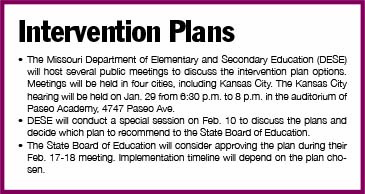By LESLIE COLLINS
Northeast News
January 22, 2014
As the state considers intervention plans for unaccredited school districts, the future of Kansas City Public Schools (KCPS) remains unclear.
KCPS has rolled out its own turnaround plan, however, for the State Board of Education to consider.
The plan, designed by a coalition of community stakeholders including the District Advisory Committee, the Kansas City Federation of Teachers, NAACP, Community Creating Opportunities, MORE2, among others, builds on the Regional School Improvement Team (RSIT) process as well as methods that have already proven successful at KCPS.
“This school system has clearly demonstrated that we can increase student achievement for all students, but we cannot rest on our laurels,” KCPS Superintendent Dr. Stephen Green said in a press release. “We must sustain and increase our progress, and the ‘Kansas City Public Schools Plan’ is the roadmap we’ll use to get there.”
In its plan, KCPS proposes that each school be individually accredited on a four level system. In addition, a School Improvement Advisory Committee (SIAC) would be formed at each school to review the school improvement plan and identify necessary action steps for addressing specific needs at the school. SIAC would consist of a principal, teacher, classified employee, parent, LINC representative and two at-large representatives.
The levels include: Level 1 – Accredited; Level 2 – Provisionally Accredited; Level 3 – Academically Stressed; and Level 4 – Lapsed (an academically stressed school that fails to demonstrate academic improvement within three years and could face closure or reconstitution).
“The goal is to intervene at the provisional level so a school would never reach the academically stressed or lapsed phase,” Green told Northeast News.
Other elements of the plan include expanding wrap-around services at schools, requiring additional weeks of professional development for all certified and classified building staff, continuing to utilize reading specialists at Level 2 and 3 schools, establishing a parent and family resource center at each school, using data to identify individual academic needs of students, appointing a Building Attendance Officer at every Level 3 school, among other initiatives.
Asked where KCPS schools stand currently in terms of the four level system, Green said 13 schools fall under Level 1, six schools are under Level 2, and 12 schools are considered Academically Stressed.
Expanding and being more strategic about wrap-around services is key, Green said, since wrap-around services support a student’s social and emotional needs and well-being.
“It transfers into their self-esteem,” he said. “They know somebody cares for them. When they are set up to do better, they do better on their academic performance.”
Examples of wrap-around services include providing immunizations, mental health care, eye exams, general exams, among others. KCPS has also hosted clothing drives for students and launched its Parent University which offers classes like financial literacy. Wrap-around services would be more concentrated in schools with the highest need and in struggling schools, he said.
“It (KCPS plan) seeks to sustain and then enhance what’s already been working and moving us in the right direction,” Green said.
Another plan under state consideration was created by Cities for Education Entrepreneurship Trust (CEE-Trust), a convener, collaborator and consultant in education for cities across the U.S. The CEE-Trust plan proposes concentrating more on wrap-around services and offering quality pre-school as well as creating a new system of non profit schools. Each school would be given more autonomy and a majority of the spending power.
“The notion of autonomy is not a new concept and it’s not something we disagree with,” Green said. “In fact, we practice that in our own way. I think it’s a matter of the degree of autonomy we may differ on.”
As for individual schools having more financial control, Green said, “At its best it works great and the school flourishes. I’ve also seen it at its worst when there was an inability or a failure to be able to manage that well. Funds were misappropriated and things didn’t go as well.”
There’s a number of requirements for spending Title I and II dollars, and it’s a tedious process, he said.
“Right now we manage that process for our individual schools to make sure we’re in compliance. Hence, we’ve had perfect audits the last three years,” Green said.
Green said the district is open to other plans but would like to see a plan that is “proactive and preventive” and focuses on “restoring and rehabilitation.”
Green pointed out, however, that if KCPS scores as well as last year or better on state assessments for the 2013-2014 school year, that state intervention will not be necessary.
KCPS is “on course” to match last year’s test scores and move beyond, he said.


















